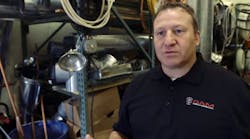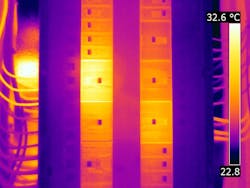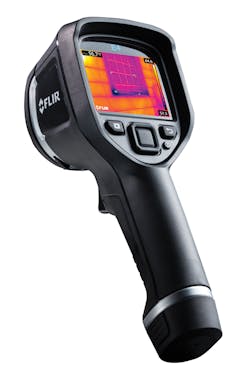Rob Camann of SAM Mechanical could hardly believe his eyes: his hand-held infrared camera had revealed a leaking steam jacket that was heating the water in a storage tank, wasting an enormous amount of energy. Camann had been contracted to conduct a thermal survey of a commercial facility. When passing by a fire cistern, he ran a casual scan that uncovered the major leak that, once corrected, ultimately led to significant cost savings for the client.
Camann’s thermal inspection business is part of a mushrooming practice for his 50-person HVACR company in New England. Not only does the inspection business allow him to serve customers around the country, but it often allows SAM Mechanical to be the first company to provide a quote on a solution for the problems the inspections reveal.
Infrared cameras for HVACR applications are far more economical than they once were. With prices starting at less than $200, these cameras offer the resolution, temperature measurement range, and thermal sensitivity needed to troubleshoot any HVACR system. They also provide dual revenue streams: from the inspections themselves and from the early opportunity to correct any problems the inspection uncovers. Just as important, economic pressures are forcing HVACR contractors to find ways to bring in more income and infrared inspections offer them a way to work faster and more efficiently.
Identify Problems Faster
Offering thermal inspections can give contractors a competitive edge by allowing them to find problems sooner. “I don’t specifically go out with anything in mind that I’m trying to find,” Camann says. “The camera literally brings it to me.”
Infrared cameras are useful for a variety of common tasks:
• Determining if a condenser’s coils are plugged or if they are low on refrigerant or leaking refrigerant.
• Spotting circuits that have blown fuses or bad connections.
• Checking coil temperatures to make sure these systems
are operating within their designed specifications.
• Detecting air pockets at high points in piping and coils
• Detecting which coils are operating and whether there are any abnormal areas
• Indirectly detecting air and fluid leaks
• Estimating operating temperature ranges of process air and fluids
• Detecting compromised duct and piping
• Determining time needed for equipment operation to reach a steady state
• Rapidly cross-checking duct/coil temperatures against BAS control points during commissioning
CLICK TO SEE A SMALL SAMPLING OF IMAGING TOOLS
When a thermal survey is performed at system startup or as part of the functional performance tests (FPTs) during commissioning, system owners can use this information as baseline data to simplify on-going predictive maintenance. When performed as a forensics study, a thermal survey can often reveal the root problems and provide the hard evidence needed to confirm a hypothesis. Using thermal images to supplement reports can highlight problem areas clearly. With thoughtful presentation, this information allows people outside of the HVAC profession, such as CFOs, to understand problems more easily. “The picture quality is so excellent that we can just have a five-second conversation and the customer understands,” says Camann. Thermal imagery also confirms that the worker identified the problem and repaired it properly.
How Infrared Camera Technology Works The heart of an Infrared camera is a device known as a microbolometer, which is composed of an array of miniscule heat-detecting sensors. Each is sensitive to specific wavelengths of infrared radiation. As infrared radiation strikes each sensor, it increases in temperature, changing its electrical resistance. A measurement of that change is converted into a temperature value; together, the temperature values of all the sensors are represented graphically as an infrared image. Cameras are available at various levels of sensitivity, resolution, and price. Typical infrared cameras for HVAC applications can measure objects at temperatures from -4 F to 482 F and offer a variety of feature and capability options: • Saving images and exporting them for use in reports • Displaying min and max temp in a box on the image • Setting alarms for over/under a user-defined temperature • Offering a picture-in-picture view of an IR area within a standard video image, allowing easy recognition of the object being measured • Interpreting details within thermal images more easily. Some of the most capable cameras now include functions such as Multi-Spectral Dynamic Imaging (MSX®) technology, which adds visible spectrum definition to IR images by detecting the edges of objects and including that detail in the thermal image. This makes text clearly visible so users can read a label or identifier within the IR image. This instantly highlights and orients problem locations and eliminates the need to refer back to a visual image for detail. Infrared cameras offer the major advantage of intuitive operation. As Camann says of his FLIR E8, “It’s extremely user-friendly. It’s as simple as look, understand what you see, and you’re on your way.” John Anderson is FLIR’s Americas Business Development Manager, Building ChannelFLIR Ex-Series™ thermal imaging cameras provide advanced thermal diagnostics for electrical











